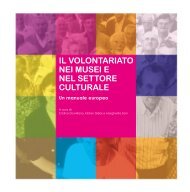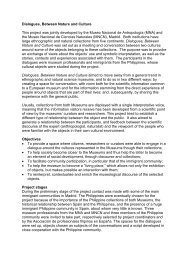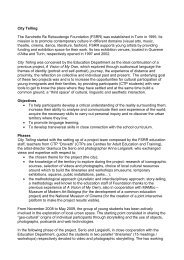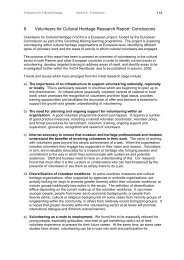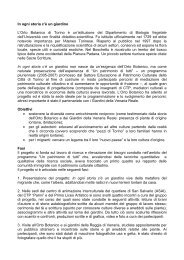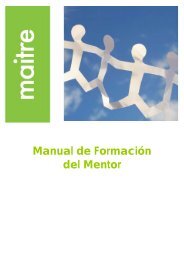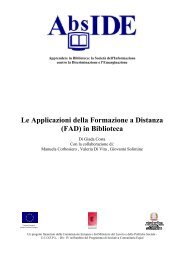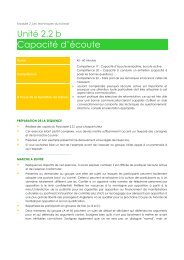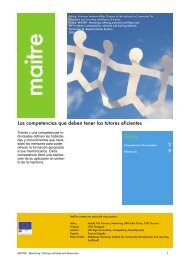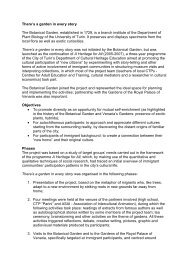Museums as places for intercultural dialogue - Network of European ...
Museums as places for intercultural dialogue - Network of European ...
Museums as places for intercultural dialogue - Network of European ...
You also want an ePaper? Increase the reach of your titles
YUMPU automatically turns print PDFs into web optimized ePapers that Google loves.
The challenge <strong>of</strong> creating “third spaces”Guidelines <strong>for</strong> MAP <strong>for</strong> ID pilot projectsSimona Bodoexchange <strong>of</strong> culturally different practices, and help immigrants retainawareness <strong>of</strong> their cultural background. It could actually be arguedthat the promotion <strong>of</strong> museums <strong>as</strong> <strong>places</strong> <strong>for</strong> <strong>intercultural</strong> <strong>dialogue</strong> isa gradual process which could be disrupted without first having takenthese important, preliminary steps.What I rather wish to emph<strong>as</strong>ise is that alongside the more establishedcultural policy responses to the growing diversity <strong>of</strong> <strong>European</strong> societies,and ideally <strong>as</strong> their culmination, there is also a strong need <strong>for</strong>strategies and programmes aimed at creating ‘third spaces, unfamiliarto both [sides], in which different groups can share a similar experience<strong>of</strong> discovery,’ 4 which comes very close to understanding <strong>intercultural</strong><strong>dialogue</strong> <strong>as</strong> a process rather than <strong>as</strong> a goal.Guidelines established <strong>for</strong> the MAP <strong>for</strong> ID pilot projectsFrom these reflections, a number <strong>of</strong> guidelines emerged which wereadopted by MAP <strong>for</strong> ID partners in order to in<strong>for</strong>m their work and toinspire the museums involved in the experimentation <strong>of</strong> new planningand operational paradigms.Needless to say, because each one <strong>of</strong> these museums w<strong>as</strong> at adifferent stage <strong>of</strong> the gradual process I just referred to – some wereindeed at their first experience <strong>of</strong> “<strong>intercultural</strong>” work – the guidelinesthat follow were to be contextualised in order to capitalise on previousinitiatives, reflect the museum’s current situation, and possibly take itone step further.They include a number <strong>of</strong> key underlying <strong>as</strong>sumptions, conceptualclarifications and methodological criteria:• Understanding <strong>intercultural</strong> <strong>dialogue</strong> <strong>as</strong> a bi-directional processactively engaging both autochthonous individuals and those with animmigrant background, which is ‘dialogical and trans<strong>for</strong>mative onboth sides,’ 5 and in which all are equal participants;• Embracing a dynamic, dialogical notion <strong>of</strong> “heritage,” wheremeanings can be renegotiated, re-constructed and made available<strong>for</strong> all to share in a social space <strong>of</strong> interaction;• Starting from the <strong>as</strong>sumption that “the p<strong>as</strong>t is a <strong>for</strong>eign country,”there<strong>for</strong>e all segments <strong>of</strong> the population – not only migrants andrefugees – suffer from a lack <strong>of</strong> cultural or historical knowledge;• Conceiving <strong>intercultural</strong> education <strong>as</strong> the “integrating background”against which any education is possible in a world <strong>of</strong> incre<strong>as</strong>ingcontact and interaction between culturally different practices, ratherthan <strong>as</strong> a compensatory activity exclusively addressed to migrantindividuals;Intercultural <strong>dialogue</strong> <strong>as</strong> an end or <strong>as</strong> a process? Policyapproaches in museums across EuropeIn 2007, ERICarts Institute carried out a study on <strong>intercultural</strong> <strong>dialogue</strong><strong>for</strong> the <strong>European</strong> Commission – DG Education and Culture. Asa research team expert, my brief w<strong>as</strong> to investigate the differentunderstandings <strong>of</strong> <strong>intercultural</strong> <strong>dialogue</strong> and the resulting policyapproaches to its promotion in museums across Europe, focusing onwhether and how interaction h<strong>as</strong> (or h<strong>as</strong> not) been promoted betweendifferent groups. 1From this overview 2 three main policy models clearly emerged, whichmay be very roughly summed up <strong>as</strong> follows:• Showc<strong>as</strong>ing difference: a “knowledge-oriented” multiculturalismintended <strong>as</strong> an educational strategy to in<strong>for</strong>m the autochthonouspublic about “other” cultures which have traditionally beenmisrepresented or made invisible in our museums;• Integrating “new citizens” within mainstream culture, by helpingthem to learn more about a country’s history, language, values andtraditions;• Promoting cultural self-awareness in migrant communities(especially refugees and <strong>as</strong>ylum seekers) through “culturally specific”programming.While it is not at all surprising to see how differently museums haveresponded to such an unusual challenge – far from being developed<strong>for</strong> the sake <strong>of</strong> cultural diversity or in order to enhance <strong>intercultural</strong>competence, most <strong>of</strong> them were historically created to represent andvalidate national or local identities – it is quite interesting to observethat, <strong>as</strong> different <strong>as</strong> they may be, these approaches to the promotion <strong>of</strong><strong>intercultural</strong> <strong>dialogue</strong> <strong>of</strong>ten have some key features in common:• They still tend to have a static, essentialist notion <strong>of</strong> “heritage,”which is primarily seen <strong>as</strong> a “received patrimony” to safeguard andtransmit;• They target communities exclusively in relation to their own culturesand collections, while cross-cultural interaction across all audiencesis generally avoided;• By keeping “majority” and “minority” cultures or communities apart,and by generally treating the latter <strong>as</strong> ‘unified, traditional, unchangingand thereby exotic,’ 3 they sometimes end up rein<strong>for</strong>cingstereotypes;• They are inclined to embrace the rhetoric <strong>of</strong> “diversity <strong>as</strong> arichness,” rather than identifying tensions and frictions which may bedealt with in order to change attitudes and behaviours;• They conceive <strong>intercultural</strong> <strong>dialogue</strong> <strong>as</strong> a goal or pre-determinedoutcome, rather than <strong>as</strong> an interactive process.By highlighting these common features, I do not wish to imply that thepolicy approaches outlined above are not correct or worth pursuing;in fact all are essential, in their own distinctive way, to promote therichness <strong>of</strong> diversity, create the conditions <strong>for</strong> the encounter and22 23



